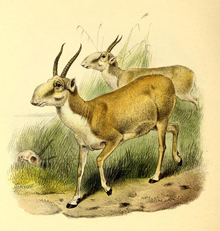 By Victoria Gill Science reporter, BBC News
By Victoria Gill Science reporter, BBC News 7 February 2017
The death of more than 2,000 critically endangered Saiga antelope in Mongolia was caused by a disease that could now threaten the entire population.
Wildlife Conservation Society (WCS) scientists, who work in the affected grassland area of Western Mongolia, say the disease originated in livestock.
It is a virus known as PPR or Peste des Petits Ruminants.
WCS veterinary scientist Dr Enkhtuvshin Shiilegdamba told BBC News that 2,500 Saiga had already died.
Researchers described the speed of the disease spread as "alarming".
"The first case of PPR was confirmed in the Saiga on only 2nd January this year," Dr Shiilegdamba told BBC News.
She and her colleagues say that this is the first deadly infectious outbreak known to have occurred in this population of animals. And beyond this one, rare species, there is concern for the impact on the wider grassland ecosystem.
"Many other species share this same range," explained Dr Shiilegdamba, "including ibex and big-horned sheep."
"If this [spreads east] and hits the gazelle population, it could be economically and ecologically devastating."
One major concern is that, with the disappearance of wildlife in the area, there will be a lack of prey for the endemic snow leopard. As well as affecting the health and population of these carnivores, this could put leopards at greater risk of being shot by farmers - as a lack of wild prey drives them to take livestock.
Professor Richard Kock from the UK's Royal Veterinary College agreed that the broader ecological consequences were potentially "dire".











No comments:
Post a Comment
You only need to enter your comment once! Comments will appear once they have been moderated. This is so as to stop the would-be comedian who has been spamming the comments here with inane and often offensive remarks. You know who you are!